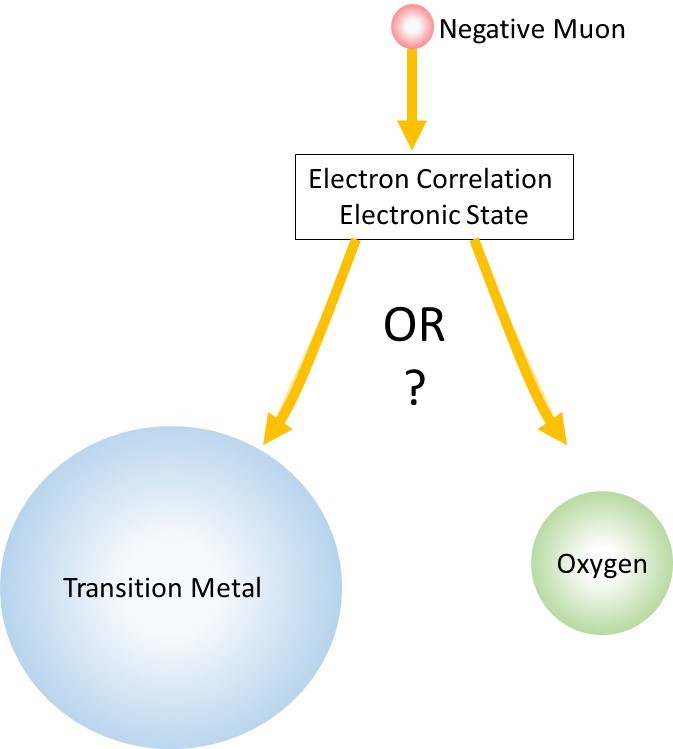| Program B01-2 | Negative muon capture process of electronic many-body effect in strongly correlated electron system |
|---|---|
| Principal Investigator | HIGEMOTO, Wataru (Japan Atomic Energy Agency (JAEA)/Tokyo Tech) |
Electron correlation in many-body system is one of the central issue
for material research. In many systems, electron correlation induces
a drastic change of electronic state and very often causes a phase
transition. For example, a metal-insulator transition is seen in
several transition metal oxides in which, although metallic state is
predicted by band theory, insulating state is realized due to strong
electron correlations. The nature of electron correlation in
many-body system is very complex and it is quite difficult to
elucidate the phenomena. To understand the origin of such a phase
transition, study of the electronic state itself is crucial. However,
it is not easy to determine electronic state in particular at deep
inside of material.
 Fig. 1. Negative muon capture ratio and electronic state.
We study electronic state in many body-electron system by using
negative muon characteristic X-ray (“Muonic X-ray”). The
muon capture probability for each element in a material (capture
ratio) can be estimated from muonic X-ray measurements. Today it is
known that the initial process of muon capture depends on the
electronic state, structure, molecular structure etc. For example,
there are differences in the per-atom muon capture ratio for several
transition metal oxides, probably due to the difference of valence
numbers. Up to now, relation between phase transition and muon
capture have not known at all. We investigate the relation between
muon capture processes, in particular muon capture ratio and
electronic state in the different phases in well characterized
materials.
Fig. 1. Negative muon capture ratio and electronic state.
We study electronic state in many body-electron system by using
negative muon characteristic X-ray (“Muonic X-ray”). The
muon capture probability for each element in a material (capture
ratio) can be estimated from muonic X-ray measurements. Today it is
known that the initial process of muon capture depends on the
electronic state, structure, molecular structure etc. For example,
there are differences in the per-atom muon capture ratio for several
transition metal oxides, probably due to the difference of valence
numbers. Up to now, relation between phase transition and muon
capture have not known at all. We investigate the relation between
muon capture processes, in particular muon capture ratio and
electronic state in the different phases in well characterized
materials.
Members
- Principal Investigator
-
HIGEMOTO, Wataru
(The Advanced Science Research Center, Japan Atomic Energy Agency (JAEA)/Department of Physics, Tokyo Tech)
- Research Collaborators
Reference Materials
- W. Higemoto, S. R. Saha, A. Koda, K. Ohishi, R. Kadono, Y. Aoki, H. Sugawara, H. Sato, “Spin-triplet superconductivity in PrOs4Sb12 probed by muon Knight shift,” Phys. Rev. B 75, 020510-1–4 (2007).
- W. Higemoto, T. U. Ito, K. Ninomiya, T. Onimaru, K. T. Matsumoto, T. Takabatake, “Multipole and superconducting state in PrIr2Zn2O probed by muon spin relaxation,” Phys. Rev. B 85, 235152 (2012).
- W. Higemoto, Y. Aoki and D. E. MacLaughlin, “Spin and time reversal symmetries of superconducting electron pairs probed by the muon spin rotation and relaxation technique,” J. Phys. Soc. Jpn. 85, 091007 (2016).
- W. Higemoto, R. Kadono, N. Kawamura, A. Koda, K. M. Kojima, S. Makimura, S. Matoba, Y. Miyake, K. Shimomura, P. Strasser, “Materials and life science experimental facility at the japan proton accelerator research complex IV: The muon facility,” Quantum Beam Sci. 1(1), 11 (2017).
- K. Ninomiya, T. U. Ito, W. Higemoto, N. Kawamura, P. Strasser, T. Nagatomo, K. Shimomura, Y. Miyake, M. Kita, A. Shinohara, K. M. Kubo, T. Miura, “Negative muon capture ratios for nitrogen oxide molecules,” J. Radioanal. Nucl. Chem. 319, 767 (2019).
